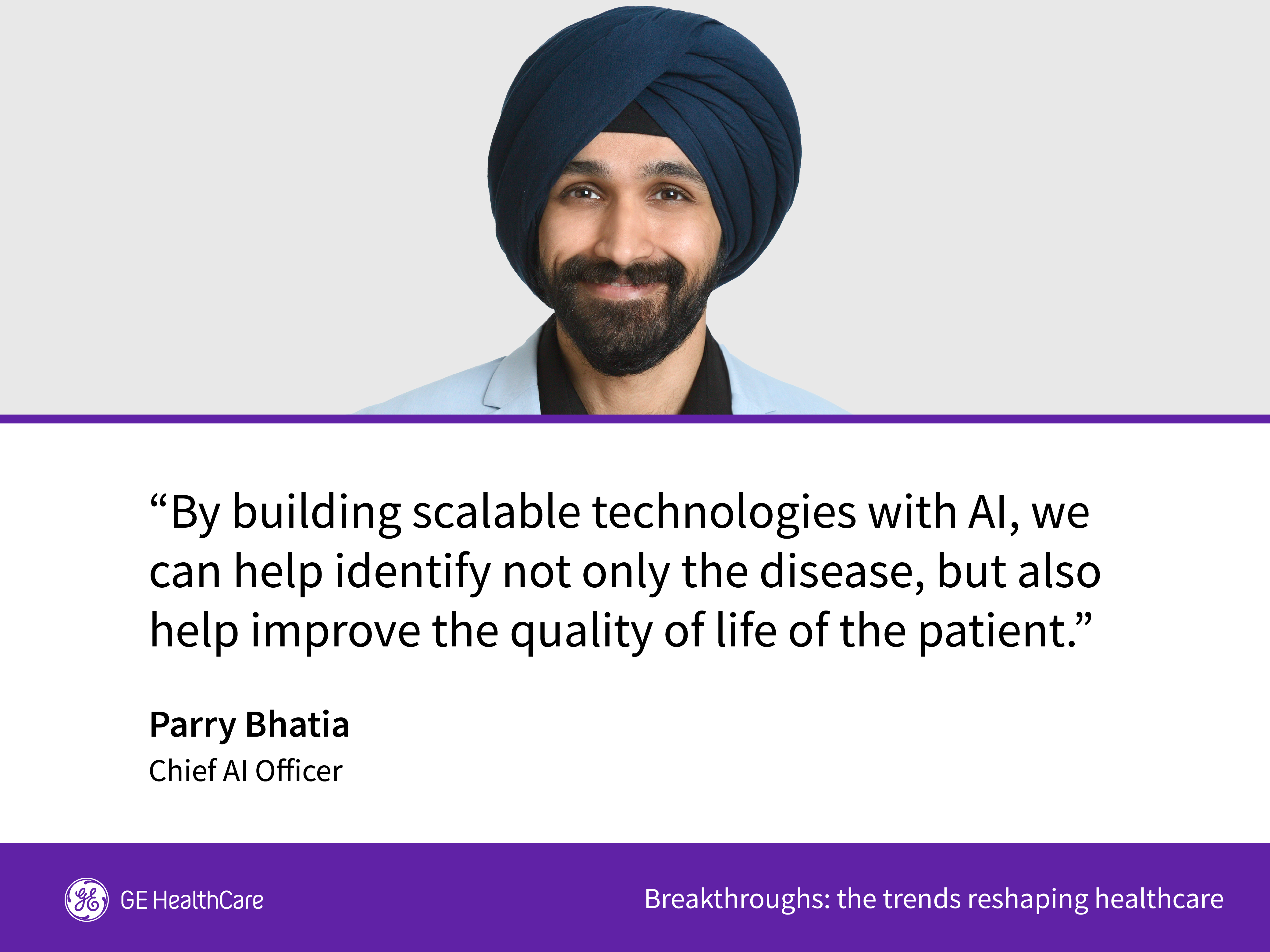By Parminder Bhatia, Chief AI Officer, GE HealthCare
This article first appeared on Parry Bhatia's LinkedIn
In the realm of healthcare, the importance of early diagnosis and treatment is widely acknowledged for saving lives. Yet, persistent barriers such as socioeconomic disparities and patient location pose challenges to ensuring universal access to quality medical care. The transformative synergy of artificial intelligence and cloud computing is poised to democratize healthcare in the next five to 10 years, ushering in an era of increased predictiveness, prevention, and precision.
Examples of AI uses in healthcare
In the past 12 to 18 months, we've witnessed a remarkable AI renaissance. Tasks initially projected to take three to five years can now be accomplished in a matter of months, thanks to the abundance of data and the accelerated growth within various ecosystems. This shift is fundamentally altering the paradigm of how we approach the integration and implementation of these technologies across diverse workflows.
The digitization of healthcare: Integrating patient information for easier queries
AI is poised to transcend its role beyond influencing patient outcomes and delve into the intricate task of comprehending and synthesizing multimodal healthcare data. Patient information manifests in various forms, encompassing medical scans, doctors' notes, and lab results, often posing a challenge due to its complexity. Through the integration of images, audio, and text, generative AI will adeptly synthesize this diverse data, extracting meaningful insights for the clinician. The transformative capability of this approach allows diverse hospital staff to effortlessly query patient records using user-friendly interfaces like natural language, streamlining processes and fostering collaborative efforts across a spectrum of care disciplines.
Much like the everyday convenience of Google search, applying multimodal search in healthcare allows clinicians to ask questions in natural language, such as, “Find me female patients age range 40 to 60 years, with X diagnosis in the last six months.” This digital tool could then swiftly identify relevant patients and their records, eliminating the need for weeks or months of the manual searching traditionally required.
Streamlining data gathering to optimize and shorten administrative tasks
Providing the clinicians with the right information, at the right place, at the right time, is really going to be accelerating in a lot of ways. This has the potential to enable better and faster diagnoses and more accurate predictions about how individual patients will respond to various treatments. This could then allow healthcare providers to tailor therapies to address specific patient issues with increased confidence in achieving positive outcomes.
In the future, utilizing voice technology, providers can establish personalized scanning protocols for patients, while AI streamlines the creation of imaging reports and notes. Processes like radiation therapy, once a three-hour affair, could then take just 15 minutes. Beyond optimizing image quality, there's a growing exploration of extending these technologies to enhance post-scan operations. This dual focus aims to accelerate both diagnosis improvement and operational efficiency across healthcare.
We’ll see more of this in the immediate future, with AI embedded into operational and administrative tasks to ramp up those efficiencies at clinics, hospitals and other institutions. Automating mundane tasks with AI decreases the amount of time providers spend on paperwork, lightening their workload and giving them the space to look for ways to improve not just a patient’s health, but also their quality of life.
Accelerated digital technology integration enables adaptability across modalities
What excites me about some of the latest technologies that are coming out with generative AI and foundation models is how they can quickly allow us to adapt across multiple disease care pathways going from screening, early detection, progression and even pinpointing non-invasive biomarkers with streamlined training.
In the past, these models would have required months or years to be developed. But they could eventually be ready to be embedded into the workflow in the matter of weeks. This adaptability extends across diverse disease areas, ranging from prostate cancer to lung cancer, and from oncology to cardiology and neurology. The ability to transfer capabilities learned from one disease to another is going to be a game-changing approach in building digital components for healthcare.
How these advancements are propelling the future of healthcare
Traditionally, we've built applications one component at a time, requiring a certain number of people or resources to scale. However, by leveraging the same resources, our aim is to achieve a tenfold acceleration, propelling us to significantly advance the future of healthcare.
At GE HealthCare, our mission is to revolutionize healthcare interfaces by seamlessly integrating technologies—voice, text, and cutting-edge AI visualizations. Beyond technological innovation, our focus is on creating user-centric tools that redefine how medical professionals engage with technology. This approach aims to enhance efficiency, ultimately elevating the overall patient experience and outcomes.



